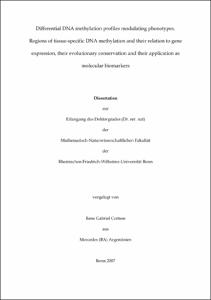Cortese, Rene Gabriel: Differential DNA methylation profiles modulating phenotypes : Regions of tissue-specific DNA methylation and their relation to gene expression, their evolutionary conservation and their application as molecular biomarkers. - Bonn, 2008. - Dissertation, Rheinische Friedrich-Wilhelms-Universität Bonn.
Online-Ausgabe in bonndoc: https://nbn-resolving.org/urn:nbn:de:hbz:5N-13601
Online-Ausgabe in bonndoc: https://nbn-resolving.org/urn:nbn:de:hbz:5N-13601
@phdthesis{handle:20.500.11811/3599,
urn: https://nbn-resolving.org/urn:nbn:de:hbz:5N-13601,
author = {{Rene Gabriel Cortese}},
title = {Differential DNA methylation profiles modulating phenotypes : Regions of tissue-specific DNA methylation and their relation to gene expression, their evolutionary conservation and their application as molecular biomarkers},
school = {Rheinische Friedrich-Wilhelms-Universität Bonn},
year = 2008,
note = {Tissue- specific DNA methylation plays a major regulatory role. The association of increased tissue-specific DNA methylation and gene silencing is widely accepted despite the lack of experimental evidence. I have approached this topic in two complementary directions. First, using direct sequencing of bisulfite-converted DNA and semiquantitative RT-PCR, I show that increased methylation correlates with decreased expression of the cognate transcript in healthy adult tissues and primary cells in 16 out of 43 (39%) tissue-specific differentially methylated regions (T-DMRs) located at the 5’-UTR of annotated genes. In the second approach, I have first determined the genome-wide expression profiles of fetal and healthy adult human lung and then studied the methylation status of 43 differentially expressed genes. Among them, highly methylated 5’-UTR regions correlate with decreased expression levels in 19% of the cases. Furthermore, this approach allowed the discovery of four differentially expressed genes in fetal lung (MEOX2, MDK, LAPTM5 and FGFR3), whose differential methylation arise as potential biomarker for lung cancer.
Next, I have studied the conservation of T-DMRs throughout the evolution. First, using direct sequencing of bisulfite-converted DNA, I show that the majority (69.4%) out of 61 orthologous regions in human and mouse differ by less than 20% in their methylation, indicating significant conservation. Additionally, by comparative DNA methylation analysis of three different gene duplication events leading to functional gene families, unprocessed and processed pseudogenes, I show that for genes that evolved recently and for some unprocessed pseudogenes, tissue-specific DNA methylation and RNA expression are conserved upon duplication.
Finally, I have studied the interaction of genetic and epigenetic alterations in modulating phenotypes in non-oncogenic diseases. The RARB gene appears highly methylated in patients with familial partial lipodystrophy (FPLD) compared to progeria patients and healthy controls. This differential methylation might explain the different phenotypes observed despite similar genetic backgrounds.
Altogether, this work presents vast experimental evidence supporting the hypothesis of differential DNA methylation patterns influencing, and in may cases determining, phenotypes in healthy and diseased tissues.},
url = {https://hdl.handle.net/20.500.11811/3599}
}
urn: https://nbn-resolving.org/urn:nbn:de:hbz:5N-13601,
author = {{Rene Gabriel Cortese}},
title = {Differential DNA methylation profiles modulating phenotypes : Regions of tissue-specific DNA methylation and their relation to gene expression, their evolutionary conservation and their application as molecular biomarkers},
school = {Rheinische Friedrich-Wilhelms-Universität Bonn},
year = 2008,
note = {Tissue- specific DNA methylation plays a major regulatory role. The association of increased tissue-specific DNA methylation and gene silencing is widely accepted despite the lack of experimental evidence. I have approached this topic in two complementary directions. First, using direct sequencing of bisulfite-converted DNA and semiquantitative RT-PCR, I show that increased methylation correlates with decreased expression of the cognate transcript in healthy adult tissues and primary cells in 16 out of 43 (39%) tissue-specific differentially methylated regions (T-DMRs) located at the 5’-UTR of annotated genes. In the second approach, I have first determined the genome-wide expression profiles of fetal and healthy adult human lung and then studied the methylation status of 43 differentially expressed genes. Among them, highly methylated 5’-UTR regions correlate with decreased expression levels in 19% of the cases. Furthermore, this approach allowed the discovery of four differentially expressed genes in fetal lung (MEOX2, MDK, LAPTM5 and FGFR3), whose differential methylation arise as potential biomarker for lung cancer.
Next, I have studied the conservation of T-DMRs throughout the evolution. First, using direct sequencing of bisulfite-converted DNA, I show that the majority (69.4%) out of 61 orthologous regions in human and mouse differ by less than 20% in their methylation, indicating significant conservation. Additionally, by comparative DNA methylation analysis of three different gene duplication events leading to functional gene families, unprocessed and processed pseudogenes, I show that for genes that evolved recently and for some unprocessed pseudogenes, tissue-specific DNA methylation and RNA expression are conserved upon duplication.
Finally, I have studied the interaction of genetic and epigenetic alterations in modulating phenotypes in non-oncogenic diseases. The RARB gene appears highly methylated in patients with familial partial lipodystrophy (FPLD) compared to progeria patients and healthy controls. This differential methylation might explain the different phenotypes observed despite similar genetic backgrounds.
Altogether, this work presents vast experimental evidence supporting the hypothesis of differential DNA methylation patterns influencing, and in may cases determining, phenotypes in healthy and diseased tissues.},
url = {https://hdl.handle.net/20.500.11811/3599}
}






